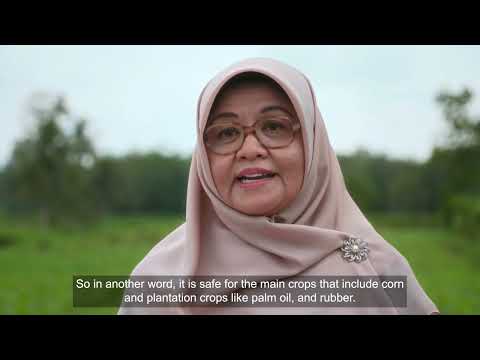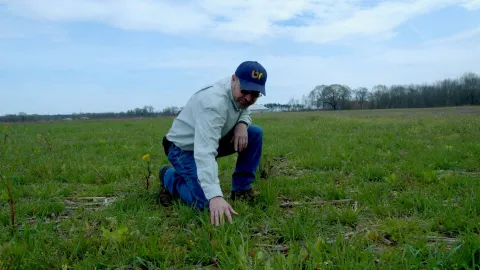
Around the world, farmers trust and rely on Syngenta to deliver advanced and innovative agricultural technologies and solutions. With our products, farmers are better equipped to grow their crops safely, productively and sustainably.
Paraquat has been used to control weeds since a Syngenta predecessor company first brought it to market in 1962. Today, more than 750 companies around the world are registered to sell this herbicide. Its place in our extensive product portfolio is a recognition of its continued importance to farmers who view paraquat as a much-needed option to safeguard crops from invasive and harmful weeds, while enabling conservation agricultural practices.
Many claims about paraquat have been made in the media and by various interest groups. As part of our commitment to be transparent, we are providing information about this herbicide, to enable you to draw your own conclusions.
Is paraquat still relevant in modern agriculture?
Paraquat is a herbicide effective against a broad spectrum of weeds. It is used by farmers as an important tool for conservation agriculture and integrated weed management, saving arduous labor and protecting agriculturally important crops such as soy, corn and cotton against invasive weeds.
Key benefits of paraquat include:
- Fast-acting: Paraquat acts quickly to desiccate and kill weeds, often showing visible results within hours or a few days. This rapid action can be crucial for farmers needing to remove existing weeds in a field before planting or to manage weed growth during the growing season.
- Effectiveness against resistant weeds: Paraquat has a unique mode of action, which makes it effective against weeds that have developed resistance to other herbicides, such as glyphosate-resistant species.
- No soil activity: Paraquat is quickly immobilized upon contact with soil, which means it doesn't have residual activity that could affect subsequent crops. This characteristic makes it suitable for use in crop rotation systems.
- Use in conservation tillage: Because paraquat can control weeds without disturbing the soil, it is compatible with conservation tillage and no-till farming practices, which help prevent soil erosion and maintain soil health. Moreover, conservation tillage and no-till farming practices have a major role to play in carbon sequestration, further corroborating the value paraquat provides to these agricultural practices.
- Desiccation: Paraquat is used as a desiccant to dry out crops like cotton and soybeans before harvest, facilitating easier and more efficient harvesting.
- Rainfastness: Paraquat is rainfast shortly after application, which is particularly beneficial in regions with unpredictable weather patterns.
- Yield Increase: The aforementioned benefits of paraquat can also increase crop yields by providing effective and rapid weed control, facilitating conservation tillage practices (improving soil health), aiding in a more uniform and timely harvest, and helping manage herbicide resistance, ensuring that effective weed control can be maintained over time.
More than 60 years since its commercial launch, many farmers still consider paraquat an essential component of their farming toolbox.
Hear from farmers and experts around the world explain paraquat’s role in farming today







Does paraquat cause Parkinson’s disease?
Syngenta rejects the claims of a causal link between paraquat and Parkinson’s disease because it is not supported by scientific evidence. Despite decades of investigation and more than 1,200 epidemiological and laboratory studies of paraquat, no scientist or doctor has ever concluded in a peer-reviewed scientific analysis that paraquat causes Parkinson’s disease. Our view is endorsed in science-based reviews by regulatory authorities, such as in the US, Australia and Japan.
Most recently, California’s Department of Pesticide Regulation (DPR) published on Dec 30, 2024 its preliminary scientific report “Potential Human Health Outcomes Resulting from Paraquat Exposure”. DPR's review of existing human health studies does not indicate a causal association between paraquat exposure and Parkinson's disease.
Further, in September 2024, Dr. Douglas Weed a physician and epidemiologist with over 25 years of experience in epidemiological research with no ties to Syngenta, published an updated meta-analysis that reaffirmed “no compelling scientific argument for claiming that an association exists much less a causal association” between paraquat and Parkinson’s disease.
Dr Weed highlights the impact of litigation-sponsored research in his study’s conclusion:
“The most recent study of paraquat and Parkinson’s disease, undertaken by investigators closely linked to the ongoing litigation, should be interpreted in the light of the problem of litigation-sponsored science. While much has been discussed about the role that industry can play in the sponsoring of and impact on epidemiologic research, much less has been written about the fact that the attorneys who represent the plaintiffs in legal actions also represent a well-funded industry with the sole mission of winning cases against corporations. I will not discuss this matter in more detail here but the fact that two of the authors of the Paul et al. paper are involved in the litigation as plaintiffs’ experts cannot be ignored. Simply put, the best explanation of the evidence available today is that a causal association has not been established, a conclusion the U.S. Environmental Protection Agency agrees with.”
We also note that Professor Martin Wells, the causation expert retained by plaintiffs in paraquat-related litigation against Syngenta in the US, was dismissed by both the US federal judge overseeing the majority of paraquat lawsuits, as well as by the California state court. The US federal judge compared Wells’ research to “unscientific cherry picking” and stated that it is a “red flag” that his view “has not been adopted or independently validated in any peer-reviewed scientific analysis outside of this litigation.”
Today, Parkinson’s affects millions of people around the world who have never used paraquat. While we have great sympathy for those suffering from the debilitating effects of Parkinson’s disease, it is important to note that paraquat is safe when used as directed, and that the scientific evidence simply does not support a causal link between paraquat and Parkinson’s disease.
Phil Botham,
Principal Science Advisor for Product Safety at Syngenta
- The hypothesis that paraquat causes Parkinson’s is not accepted in the medical community or peer-reviewed science, nor has it been accepted at any time in the past
- Our response regarding California’s Central Valley study by Paul et al (2024)
- Our response to Dr. Deborah Cory-Slechta, who has been featured in various recent media reports
What actions has Syngenta taken to ensure paraquat can be used safely?
At Syngenta, we take the safety of our products very seriously. We have invested tens of millions of dollars to ensure the safety and safe use of paraquat, and have contributed significantly to the more than 1,200 safety studies submitted and reviewed by regulatory authorities around the world. Today, we remain at the leading edge when it comes to industry efforts to drive continuous improvement in the safety of the products that we offer.
Why are media and activist organizations interested in paraquat?
In the United States, Syngenta is among the latest targets of the ‘Mass Tort Machine’, as numerous plaintiff law firms seek to enrich themselves through recruiting claimants to allege that people have been harmed by paraquat. The U.S. Chamber of Commerce estimates the nation’s tort system cost the U.S. economy $443 billion in 2020 alone. The goal of these lawyers is to sign up enough claimants to seek to pressure companies that manufacture or sell the product to settle the cases. The law firms typically keep 30 to 40 percent of any settlement. Using this strategy, law firms can make a significant amount of money, often without ever having to prove their clients were even harmed.
There have been many U.S. plaintiffs firms and claims generators engaged for years to generate as many claims as they can, sometimes without regard to whether their clients actually have Parkinson’s disease, have used or have been exposed to paraquat. These law firms advertise heavily on television, radio, online and with mailings (spending millions of US dollars).
According to David Williams, president of Taxpayers Protection Alliance, “Trial lawyer advertising (often funded by Wall Street investors) has reached epic proportions. One study found that television legal advertising in 2021 compromised more than 15 million commercials, with spending levels topping $1 billion annually. Between 2017 and 2021, $6.8 billion was spent on more than 77 million national and local ads.”
Those advertisements are often misleading or make false claims, such as suggesting paraquat would be applied to healthy crops or that gardeners and golfers can be exposed to paraquat when - in fact - it is and has always been illegal to use paraquat in home garden and golf course environments in the United States.
In April 2024, the US federal judge overseeing the majority of paraquat lawsuits rejected the plaintiffs’ causation expert Professor Martin Wells, on grounds that his data analysis relied on “unscientific cherry picking”. The judge also stated that it is a “red flag” that Well’s view “has not been adopted or independently validated in any peer-reviewed scientific analysis outside of this litigation.” Later, in November 2024, the California state court also excluded Wells, stating: “The court has concerns about Dr. Wells’ methodology and scientific technique. From the outset, the Wells original report and Dr. Wells’ deposition testimony regarding his process for locating studies and then selecting them for further review and ultimate use for his meta-analysis was not conducted in a manner consistent with the practices of the published systemic reviews as described in his own original report. Even if that haphazard process did not result in Dr. Wells’ missing important studies he should have considered, it is a blot on the scientific methodology he employed where ‘form,’ including transparency and objectivity, is an important aspect of the scientific technique and intellectual rigor expected from experts.”
Facing the Mass Tort Machine:
- Plaintiffs’ causation expert Martin Wells was twice barred from testifying. In April 2024, the US federal judge overseeing the majority of paraquat lawsuits rejected the plaintiffs’ causation expert Martin Wells, on grounds that his data analysis relied on “unscientific cherry picking”, and that it is a “red flag” that his view “has not been adopted or independently validated in any peer-reviewed scientific analysis outside of this litigation.” Later in November 2024, the California state court also dismissed Wells, describing his work as “haphazard” and “a blot on the scientific methodology”.
- Independent scientist calls out the impact of litigation-sponsored research: Dr. Douglas Weed, a physician and epidemiologist with over 25 years of experience in epidemiological research with no ties to Syngenta, studied epidemiological meta-analyses since 2006. In his update (published September 2024) to his 2021 study he takes into account studies since 2019. He states: “The most recent study of paraquat and Parkinson’s disease, undertaken by investigators closely linked to the ongoing litigation, should be interpreted in the light of the problem of litigation-sponsored science. While much has been discussed about the role that industry can play in the sponsoring of and impact on epidemiologic research, much less has been written about the fact that the attorneys who represent the plaintiffs in legal actions also represent a well-funded industry with the sole mission of winning cases against corporations. I will not discuss this matter in more detail here but the fact that two of the authors of the Paul et al. paper are involved in the litigation as plaintiffs’ experts cannot be ignored. Simply put, the best explanation of the evidence available today is that a causal association has not been established, a conclusion the U.S. Environmental Protection Agency agrees with.”
- Plaintiffs lawyers improperly file on behalf of dead plaintiffs – more than 20 plaintiff law firms improperly filed dozens of actions on behalf of already deceased plaintiffs, served sworn questionnaires to the Court on behalf of deceased plaintiffs without disclosing their deaths, and apparently even copied the signatures of deceased plaintiffs to make it appear they were attesting to facts after their deaths. This is pervasive misconduct and given the limited information available to Syngenta, it is likely these discoveries are only the tip of the iceberg.
- 1,500+ claimants – have dismissed their cases – including bellwether cases – as of January 2025.
- American Tort Reform Association, has more information about the Mass Tort Machine’s practices:
ATRAwebsite
The Hidden Money Behind the Litigation
Here are links to interesting news media articles:
- In paraquat lawsuits, an expert gets bumped (again) - Reuters
- Houston plaintiff attorney fails to answer questionnaire in Paraquat MDL – Madison Record
- Judge rejects key expert in paraquat lawsuits, tosses first cases set for trial – Reuters.com
- MDL Judge: ‘Significant number of plaintiffs can’t allege paraquat exposure’ – law.com
- Rosenstengel orders depositions of plaintiffs in paraquat MDL over concerns some cases 'do not plausibly allege exposure to paraquat' – Madison-St Clair Record
- The Latest Ad Boom: Lawyers Seeking Plaintiffs for Mass Litigation Ad Flood reflects growth in mass product-liability and personal-injury cases - and investor interest – The Wall Street Journal (Subscription required)
- The cautionary legal tale of Roundup – Townhall.com
- Syngenta, Chevron identify 611 questionable paraquat claims after discovering some active litigants were deceased – Madison-St Clair Record
- Does paraquat cause parkinson’s disease? An academic review of reviews says ‘No’ – Genetic Literacy Project
- The Hottest Mass Tort Leads for 2023 – Leading Response
- The Time for Tort Reform Is Now – Inside Sources
- Inside the Mass-Tort Machine That Powers Thousands of Roundup Lawsuits – The Wall Street Journal (subscription required)
Paraquat FAQs
Here, we wish to provide answers to further questions that have been raised.
- What is paraquat, and what is it used for?
- Is Syngenta the only company that sells paraquat?
- Is Syngenta putting profit motive above human safety?
- What do farmers need to consider to ensure the safe use of paraquat?
- Does paraquat represent a safety risk to humans?
- What specific product stewardship measures are there?
- Does paraquat represent a risk to the environment?
- Is paraquat PIC (Prior Informed Consent) listed?
Links to scientific studies
Paraquat has been the subject of more than 1,200 safety studies submitted to, and reviewed by, regulatory authorities around the world including recent evaluations in the US, Australia and by the FAO/WHO.
We provide here links to studies conducted both independently and by Syngenta:
Our Stories
From helping smallholder farmers boost yields and reduce the need for manual labour, to enabling largescale farmers to preserve their soils amid drier climates, paraquat is in many ways still considered an essential tool in a farmer’s toolbox. Read about the stories of farmers and agricultural experts from around the world.







